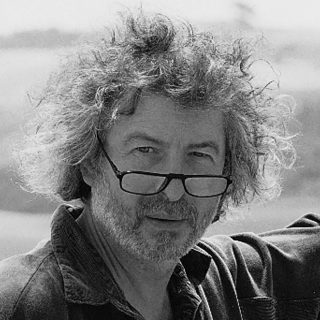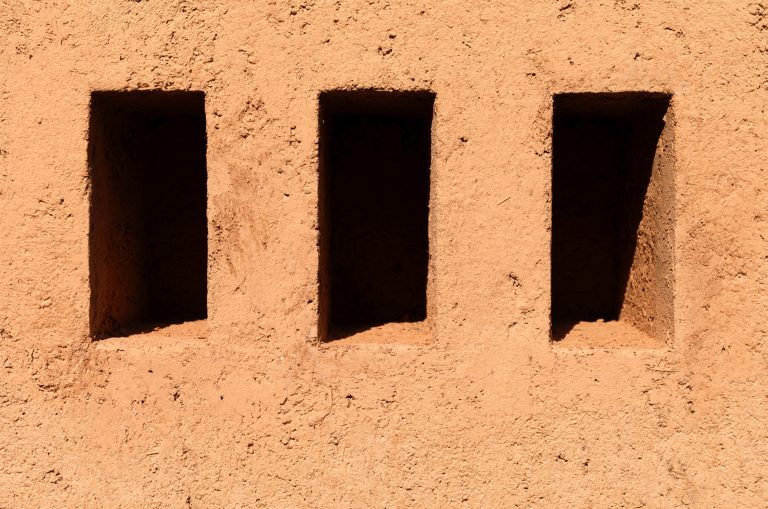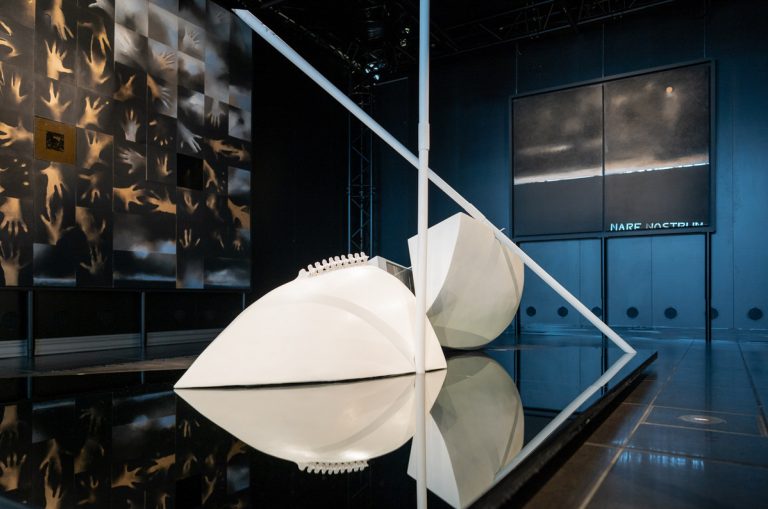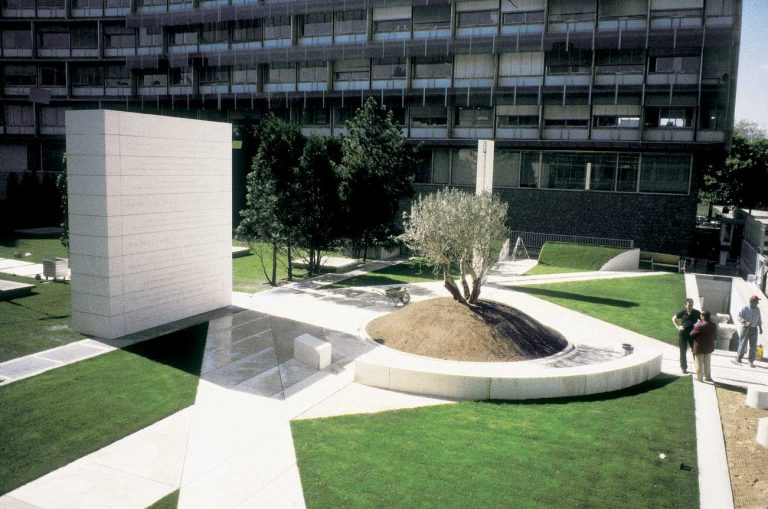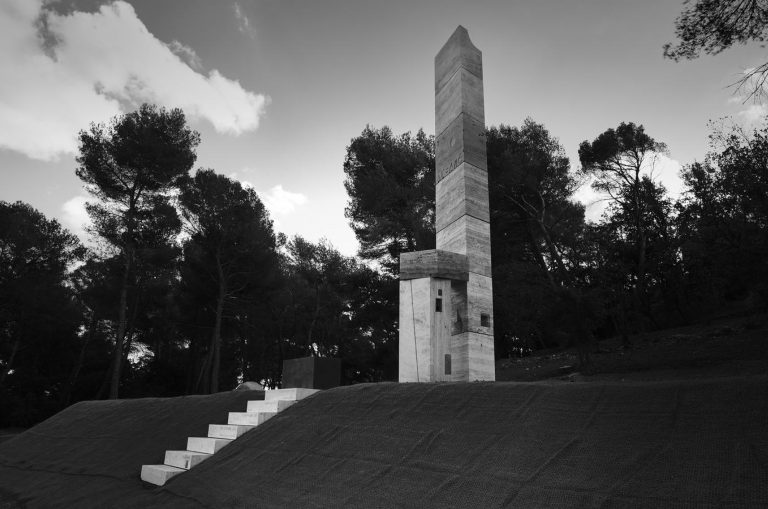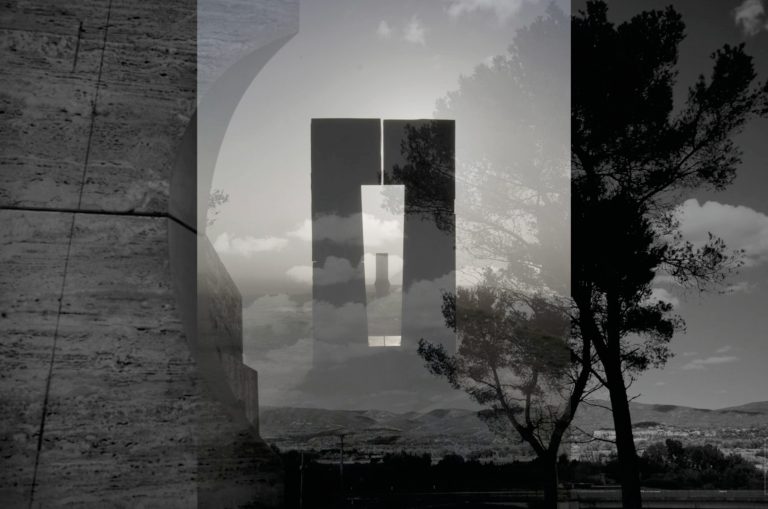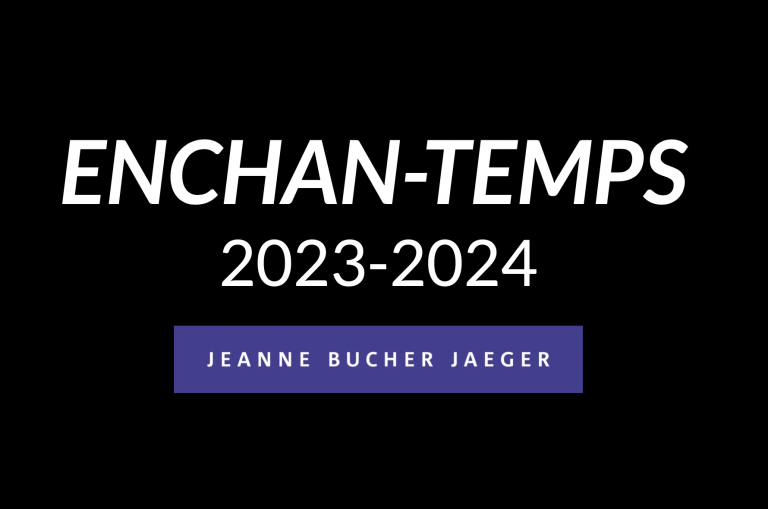04.02.2023 — 05.07.2023
Enchan-Temps: Inhabiting the Earth – Intimate Archaeology [Habiter la Terre – Archéologie intérieure]
Dani Karavan, Jean-Paul Philippe
Marais Space
Past
Wouldn’t sculpture be a means
for putting one’s heart
in the middle if the landscape for all to see
Bernard Noël, Lettre verticale XXVII
The gallery is pleased to present the first exhibition in a cycle of three about Space and Time, memories of people and landscapes, impressions and pathways, imprints on the environment, songs and enchantment.
In a time particularly prone to dispersion, uprooting, speed, ephemerality and images that make a splash without making sense, it seemed essential to us to show works that deal with meaning, the senses and memory – the memory of artists whose work has been rooted in nature and its history for more than 40 years. Artists whose work – unique and profound, at human scale – is visionary, especially in the context of the period in which their forms and sculptures were conceived.
This cycle, entitled ENCHAN-TEMPS, will be shown in the gallery’s Marais space throughout the years 2023-2024. It begins with an overview of two artists whose work has long been represented by the gallery:
DANI KARAVAN (1930 – 2021) and JEAN-PAUL PHILIPPE (1944).
At a time of deep reflection on local zero-carbon resources, natural elements such as earth, wood and stone are being restored to their former glory, developing into innovative materials in contemporary creation. This exhibition aspires to make us feel how precious the Earth is, how alive, how vibrant, how nourishing and celestial, both as a creative material and as a place to live, an embodiment of dual notions of interiority and exteriority, intimacy and cosmic, instant and history.
I always start from a place, from a dialogue with this place, and try to understand what it is asking. It is the place that creates my work.
Dani Karavan
The gallery is showing a series of works in raw clay by Dani Karavan, notably his large relief entitled Ohel Shalom – Tent of Peace, which echoes so much of what is happening in our contemporary world. Raw earth is a poor material, accessible and resilient, used for nearly 11,000 years throughout the world: Mesopotamia, Egypt, Pakistan, China, Peru, North and Central America, Africa… Raw earth concrete is compacted soil, and Dani Karavan’s sculptures are mainly made with the adobe technique, an ancestral technique used in the design of Congolese huts, mosques in Mali, parts of the Chinese Wall and traditional dwellings in Brittany and Beauce… Concrete clay and wood are combined in some of the artist’s totemic sculptures. While the 12th and last station of his Axe Majeur in Cergy-Pontoise, a 3-kilometer-long sculpture begun in 1980, was still in progress, Dani Karavan wanted in his final works to return to small-format sculptures, revisiting the traditional constructions of his ancestors’ villages, working on simple and universal forms in keeping with the spatial sculptures of such great 20th-century artists as Brancusi, Noguchi and Giacometti.
Following so many artists who, since prehistoric times, have striven to constrain natural forms, to reduce their exuberance, to bring them back to the rectitude of an ideal cosmic order, Dani Karavan inscribes the signs of humankind, both of reason and the sacred, in the landscape. Thus in Cergy-Pontoise, in the heart of the baroque setting planted by Bofill, he erected an austere tower similar to the one erected in the 13th century by the patricians of the Lombard cities. The shadow of this building describes the changing orb of solar time on Earth. Georges Duby
A film on Dani Karavan’s early, iconic work the Negev Monument, the artist’s first site-specific environmental sculpture, initiated in 1963 and completed in 1968 – at a time when environmental art did not exist – was produced by the gallery for this exhibition. Made in homage to the members of the Palmach Negev brigade who died during the War of Independence in 1948, Karavan created a series of sculptures emerging from the desert of Beer Sheva – a total work of art created from elements of nature, the senses and memory that later became part of his artistic language: drawings created by sunlight, the wind, water’s passageways and reflections, the density of the Earth as a space that is both inhabitable and inhabited, universal and sacred geometric forms, the memory of place, the welcoming of a human presence into its heart. This “Monument to Life” carved of raw concrete includes eighteen symbolic elements evoking the War of Independence: a perforated tower referring to a bullet-riddled watchtower; a pipeline evoking the defense battles ensuring the supply of water to the localities; texts engraved in the concrete with the names of the 324 fallen soldiers, passages from the soldiers’ diaries, the Brigade’s battle register, biblical verses and song lyrics…
Many of Dani Karavan’s works are marked by the issue of memory and human rights, such as the bas-relief Prayer for the Peace of Jerusalem made for the Knesset, conceived in the spirit of the founding of the State of Israel, depicting an abstract landscape of Jerusalem, its surrounding hills and the Judean desert. My work reminds members of parliament that they are working by a wall that represents peace and human rights, and where letters from the two languages, Hebrew and Arabic, are the same size. I used stones from the quarry of an Arab village, Dir el Assad, from a colony from which I want to remove nothing. I will continue to create in this sense from the grave. Dani Karavan
Jean-Paul Philippe used to say that the dust emanating from stone, when he shapes it, is the dust of time. If you were to descend into the center of the Earth, you would realize that millions of years are inscribed in the stone. The 7 stones of Jean-Paul Philippe’s Site Transitoire installed in the Crete Senesi, in the heart of a breathtakingly beautiful Tuscan landscape between Siena and Asciano, could represent in light and space, the limits of a dwelling with an invisible threshold. A few flagstones on the ground, a chair, a bench, a window, and the sky as a roof. Through the grace of the appearance of the moon and sun, the shadow of this stone furniture traced its path on the ground, telling of a motionless journey night and day. At the summer solstice, the solar disk goes down to the plumb of the stone window and disappears behind the hills (…) Jean-Paul Philippe. The artist makes several elements of gray basalt interact with nature, creating a monumental work in which stone embraces the site in harmony with the cosmos.
Jean-Paul Philippe’s sculptures are built into the landscape, creating mazes, labyrinths, wheels, chairs… The artist uses a wide variety of stones, such as marble, granite, alabaster, basalt, travertine… Each stone has its own soul, and is shaped in a unique way. You only have to look at the artist’s hands to see what an exceptional craftsman he is. Simple, primitive geometries, odes to the immutable and to silence, to nature and to memory, they give of themselves in a naked, essential truth, and invite contemplation – in the etymological sense of the word, contemplor, to connect with a defined area of sky – space and time, shadow and light, people and the stars, forever and the instant.
The stones in Site transitoire take on the aridity of the clay; their silence dries the language of the landscape and transforms the hills into a bareness of the senses, and it is from this zero degree of meaning, from this elementary vanitas of the word, that a dialogue opens between the sculpted stones and the landscape, an exchange of glances and reflections. The monumental window is a landscape towards the open, but it is also a passage for the wind that caresses the surfaces and speaks a language of pure sonority, a music of before and after the language of men. The basalt blocks unite: they embrace space and, in space, the grass, the distant cypresses, the ridge lines, the order of the hills (…) With their forms – with their thought made form – the stones raised on the earth bring the distant sky back to their own immobility. The movement of the clouds, the colors of the dawn, the anxiety of the sunset are as many precipitations on the sculpture, while its exposure to the rain, the snow, the sun is an offering of silence to the language of nature and solitude, to the distress of the signs that inhabit — the flow of the day – of the light of day. (…)
Antonio Prete, La pierre, l’écriture, Jean-Paul Philippe, Archéologies intérieures
The twinning of the town of La Roque d’Anthéron with that of Asciano naturally gave rise to the desire to materialize this link in an enduring way with the creation of a sculptural work echoing both the Site Transitoire, created by Jean-Paul Philippe, and the special relationship between the Commune of La Roque d’Anthéron with the ITER program. When I thought about the work Résonances, which was inaugurated in October 2022 and echoes Site Transitoire, one of my first intentions was to evoke the work of Albert Camus. An affectionate and discreet homage, mixing one or two words or significant sentences by the writer, who is buried on the other side of the Durance river, with the stones. I was thinking of the last sentence of his philosophical essay The Myth of Sisyphus.
« One must imagine Sisyphus happy ». Jean-Paul Philippe
About forty works are exhibited in the exhibition – some twenty for each artist – and their major preoccupations and themes are being shown. These include models and drawings of Dani Karavan’s very first environmental sculpture, which came out of the Beer Sheva desert in the 1960s, entitled the Negev Monument, accompanied by a short video made especially for the exhibition that allows you to experience the work as if you were onsite as well as the artist’s most recent sculptures and bas-reliefs made in raw earth, his large bas-relief Ohel Shalom – Tent of Peace. Jean-Paul Philippe’s works include models, drawings, and sculptures related to his Site Transitoire in Asciano, Italy, made up of 7 sculptures of windows, wheels and labyrinths installed in the landscape in Crete Senesi in the 1990s, as well as the scalemodel of his most recent work, the twin sculpture Resonances, newly inaugurated at La Roque d’Anthéron in France, completed with sculptures of marble, alabaster, granite, basalt and corten steel and reflecting the artist’s common themes, such as melancholy and the game of hopscotch…. These are shown with the film Pelle della Luna on the Site Transitoire as well as images of works or sites created by the artist in France, Egypt, Italy, Belgium and beyond.
The cycle ENCHAN-TEMPS continues after this first chapter Inhabiting the Earth – Inner Archaeology [Habiter la Terre – Archéologie Intérieure] with two other exhibitions:
Antoine Grumbach’s The Eyes of the Sky [Les Yeux du Ciel], a magnificent look at the Earth in the Landscape and offered to the Sky, evocative of the Geoglyphs of Nazca in Peru. The site is located in the axis of the runways at the Charles de Gaulle-Roissy airport on a plateau 1.6 kilometers long and 30 meters high. This is one of the largest sites for the reuse of excavated earth in the construction and public works industry, developed by the company ECT. For such an exceptional site, the company wanted an exceptional achievement. Driven by the conviction that the inert and excavated earth from construction sites that Antoine Grumbach, an architect and artist, has known all his life is not waste but rather a noble material that reconciles circular industry, landscape and art on a large scale, he proposed to the ECT company that manages this land a work of aerial art to beautify it. Two Eyes (400m x 170m each) will be visible from inside the airport, and also by the people landing at Roissy who will be able to contemplate it from the sky. The first eye, comprising a vegetal labyrinth, will be inaugurated next June for our exhibition. The second eye will include a maze, and will be inaugurated in 2026. The exhibition will focus on drawings, models and sculptures of this project as well as Antoine Grumbach’s other major projects, the Nouveaux Belvédères in Greater Paris and his Axe Paris-Le Havre, which redraws the Paris-Rouen-Le Havre Axis, of which the Seine is the main avenue, with an axis of Sky/Earth/Water/Light, the elements indispensable for all life on earth.
The Breath of Here – The Water Beyond [Le Souffle d’Ici – L’Eau de là] by Susumu Shingu, a sculptor of water and wind with whom we have been collaborating since 2006 and who created his Wind Museum in Japan, recently exhibited his work at the Château de Chambord on the occasion of the 500th anniversary of Leonard de Vinci’s death. Susumu Shingu is currently preparing an exhibition in Japan entitled Parallell Lives with Renzo Piano. They have completed more than 12 projects together. This exhibition will also be an opportunity to explore Susumu Shingu’s research into perpetual motion, based on the natural energies that inspire his sculptures, with drawings, paintings, sculptures and scalemodels of his major projects.
From the first constructions made in raw earth nearly 11,000 years ago to today, raw earth architecture has consistently developed across the continents: Mesopotamia, Egypt, Pakistan, China, Peru, North and Central America, Africa… At a time when we are thinking deeply about local “zero-carbon” resources, earth and stone no longer seem inert, appearing on the contrary to be innovative materials that take on meaning in architectural and artistic creations. The word EARTH expresses ideas of both materiality and intimacy, with this double notion of interiority and exteriority, of a container. As for STONE, it is a landscape of memory, in its immobility as in its silence, in that it crystallizes space and offers up condensed time, inviting simultaneously the Always and the Moment. Earth and Stone are thus living materials bringing the outside inside, making us feel something obvious that is specific to the work of Dani Karavan and Jean-Paul Philippe, both sculptors of a timeless Presence in the work. Inhabiting the Earth – Intimate Archaeology can then coexist.
Véronique Jaeger
(…) From my house, I could see the sunrise over the mountains surrounding Jerusalem. At the time, it was at the edge of the construction of Tel Aviv, now it’s in the city center. There were only a few houses, then sand. Most of the time I walked barefoot; it was these different sensations that marked me, the very hot sand, the wet sand. I think I created my first bas-reliefs with my feet (…)
I work in order to invite people to communicate with the environment, the materials, memory, themselves.
Dani Karavan
The stone I work with absorbs a whole range of sensations, of emotions perceived here and there, landscapes of memory, fragments of voyages… Under my hand, it seems like a need to give back. Perhaps it’s the obligation of memory? A passport to immobility? Stone is silence. Choosing this material over any other, choosing to approach stone, is already approaching silence… Stone is memory. (…)
Jean-Paul Philippe
ENCHAN-TEMPS : a cycle of three exhibitions around space, time, environment, enchantment.
From February 4 to July 8, 2023
Inhabiting the Earth – Intimate Archaeology [Habiter la Terre – Archéologie intérieure]
DANI KARAVAN – JEAN-PAUL PHILIPPE
Opening Saturday February 4, 2023
September 16, 2023 – January 15, 2024
The Eyes of the Sky [Les Yeux du Ciel]
ANTOINE GRUMBACH
February – April 2024
The Breath of Here – The Water Beyond [Le Souffle d’Ici – L’Eau de là]
SUSUMU SHINGU
practical informations
Marais Space
5 rue de Saintonge
75 003 Paris – France
T +33 1 42 72 60 42
F +33 1 42 72 60 49
info@jeannebucherjaeger.com
opening hours
Tuesday to Friday
from 10 am to 7 pm
On Saturday from 11 am to 7 pm

